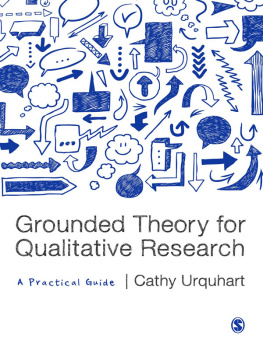
Basics of Qualitative Research
Fourth Edition
To Anselm
December 16, 1916September 1996
Scholar and Humanist
Who touched the minds and lives of all who came into contact with him

Basics of Qualitative Research
Techniques and Procedures for Developing Grounded
Theory
Fourth Edition
Juliet Corbin
International Institute for Qualitative Methodology
Anselm Strauss

FOR INFORMATION:
SAGE Publications, Inc.
2455 Teller Road
Thousand Oaks, California 91320
E-mail: order@sagepub.com
SAGE Publications Ltd.
1 Olivers Yard
55 City Road
London EC1Y 1SP
United Kingdom
SAGE Publications India Pvt. Ltd.
B 1/I 1 Mohan Cooperative Industrial Area
Mathura Road, New Delhi 110 044
India
SAGE Publications Asia-Pacific Pte. Ltd.
3 Church Street
#10-04 Samsung Hub
Singapore 049483
Copyright 2015 by SAGE Publications, Inc.
All rights reserved. No part of this book may be reproduced or utilized in any form or by any means, electronic or mechanical, including photocopying, recording, or by any information storage and retrieval system, without

permission in writing from the publisher.
Printed in the United States of America
ISBN 978-1-4129-9746-1
Library of Congress Control Number: 2014956185
This book is printed on acid-free paper.
Acquisitions Editor: Vicki Knight
Editorial Assistant: Yvonne McDuffee
Production Editor: Laura Barrett
Copy Editor: Megan Markanich
Typesetter: C&M Digitals Ltd.
Proofreader: Tricia Currie-Knight
Indexer: Jean Casalegno
Cover Designer: Scott Van Atta
Marketing Manager: Nicole Elliott
Brief contents
Reflective Inquiry
Analysis
Preface
Also at my intellectual core perhaps is the sense thathowever
nave you thinks this isthe world of social phenomena is
bafflingly complex. Complexity has fascinated and puzzled me
much of my life. How to unravel some of that complexity, to order
it, not to be dismayed or defeated by it? How not to avoid the
complexity nor distort interpretation of it by oversimplifying it out of existence? This is of course, an old problem: Abstraction
(theory) inevitably simplifies, yet to comprehend deeply, to order, some degree of abstraction is necessary. How to keep a balance
between distortion and conceptualization? (Strauss, 1993, p. 12)
Since Basics of Grounded Theory was first published in 1990, this book has come a long way. When Anselm Strauss and I wrote the first edition of this book it was meant primarily for our own students. We never thought it would attract much of an audience beyond that group. In preparing to write this fourth edition, I went back and looked at some of those earlier editions and was surprised to see how much the book has grown in depth and breadth.
Never fear, the basics of Basics have remained the same for each edition.
Over the years chapters have been expanded and contracted, been combined and broken apart, all in an effort to make the book easier to read. This edition also is an attempt to make the book more readily understandable to beginning grounded theorists. All of the chapters have been closely examined by me and re-organized with new headings added to each chapter. Parts of each chapter have been rewritten to increase clarify of major concepts. There are additional examples provided in each chapter to illustrate major analytic points especially in regards to analyzing data for context and integration.
Some of the denser chapters from the third edition have been broken apart to make it easier for readers to grasp the material they contained. In
and in the chapter on writing and doing presentations to fill in areas where the book might be lacking such as with interviewing.
This book has been divided into three parts with a short introduction to each,
is practical in nature. It offers suggestions for writing papers, monographs, dissertations, and doing presentations along with demonstrations of how to write an outline for each.
There is a chapter that discusses how to evaluate the quality of ones own and others grounded theory and a short new section on application of theory to research, teaching, and practice. The final chapter is one devoted to student questions and answers. I want to make it clear to readers that the three parts of the book are not meant to be read separately. The material in the first part of the book is meant to be used in conjunction with the second part with readers going back and forth between a discussion of procedures and demonstration of application of those procedures. Readers can go to to find answers to questions posed by other students, questions that they too might have.
on memos and diagrams now follows
on theoretical sampling follows. It discusses theoretical
sampling, a specialized form of data gathering particular to grounded theory.
constructing theory. a brief chapter on the use of computer data analysis programs in qualitative research.
Throughout
explains how to bring process into the analysis and demonstrates integration. Readers of this text will notice that for teaching purposes I break analysis down to its major elements. I acknowledge that analysis is more complex than these breakdowns imply because persons thought processes are more complex. As analysts are breaking data down, they are also noting relationships. As they are delineating concepts, they are also identifying properties and dimensions. Throughout the analytic process, they are working toward integration. The breakdowns are made so that novices can put a name on what they do and be somewhat systematic and at the same time flexible about their analyses.
A research study is not complete until it is critiqued and made available to others. This final part of the book, offers suggestions for preparing dissertations and monographs, writing papers, and doing presentations.
responds to questions often posed by students and other researchers regarding grounded theory. We hope that these sections provide a fit conclusion to the book.
Most of all, this book remains a tribute to Anselm Strauss and the legacy he has left behind. It has been an honor and joy to write and his memory remains buried deep in these pages.
Juliet Corbin
Acknowledgments
I want to thank my husband Dick for his support and encouragement during the long process of getting this edition completed. I also want to thank Vicki Knight for talking me into writing this edition and then pushing me hard to finish the book. Yvonne McDuffee, Vickis assistant, has been an immense help in keeping track of all the details and I appreciate all her efforts. Megan Markanich is a wonder for her excellent and rapid work of copy editing. In addition, I am most appreciative of the comments and suggestions provided by the following persons who reviewed the fourth edition manuscript and provided such helpful suggestions and comments. They are:
Next page









